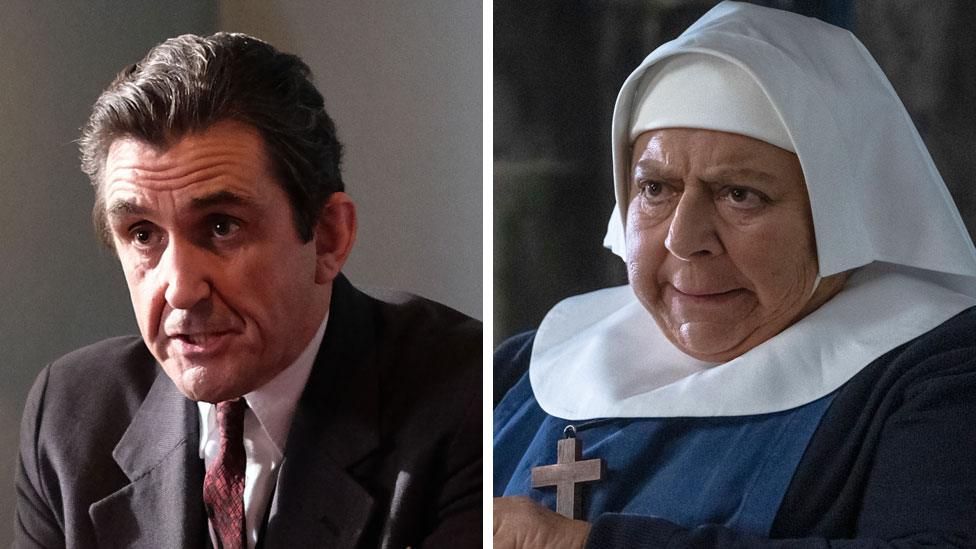Call the Midwife: The real-life nurses who inspired a Scottish adventure
- Published

The Call the Midwife characters swap the busy streets of Poplar for the wild and rugged Outer Hebrides
The 2019 Call the Midwife Christmas Day special ventured from its East London base to Scotland's Outer Hebrides where stories about child birth, illness and remoteness found inspiration from the real life tales of the Queen's Nurses. They were a group of women who took on the roles of nurse, midwife and even doctor in remote communities with limited access to modern medicine or transport.
From travelling on motorcycles and boats, to concocting homemade "medicines" made out of rabbit and tripe, the work for these women never ended.
Heidi Thomas, Call the Midwife's executive producer and writer, said she was "captivated" by their resourcefulness.
And she hinted that it could even lead to a spin-off programme about Scottish nurses in the future.
Who were the Queen's Nurses?

Queen's Nurse Catriona MacAskill weighs a newborn

These women were part of the government-funded Highlands and Islands Medical Service (HIMS), a unique trial of free medical care introduced 35 years before the creation of the NHS.
The work of the Hebridean Queen's Nurses included everything from looking after the terminally ill, to dressing wounds and caring for new mothers and their babies.
After receiving pioneering training in Glasgow or Edinburgh, they worked alone supporting entire rural communities, according to author Catherine Morrison.
A retired nurse herself, Ms Morrison documented the stories of these women in her book Hebridean Heroines which was published in 2017.
The nurses had to make do and provide care in any way they could, without any of the drugs or facilities we know today, she explained.
Ms Morrison said this could involve walking for miles round the islands to get to appointments, often faced with extreme snow and rain.
Transport was one of the biggest issues they faced - the islands were not well-connected to the mainland and some were only accessible by boat.
Treating a premature baby with cod liver oil

Many nurses used motorbikes to get round the islands for appointments
One Queen's Nurse looked after an undernourished, premature baby. With no hospital nearby, the nurse decided to douse the baby's skin in cod liver oil with cotton wool in a bid to save its life with nutrients.
The doctor returned to the island two weeks later and was equally "surprised by how much the baby had improved in the nurse's care and confused by the strong, fishy smell coming from the infant," Ms Morrison said.
Although there is no proof that it was the nurse's decision which saved the newborn, she said it showed "how the nurses did what they could" to care for their patients despite the scarce resources.
She said one nurse even had to save a little girl who had fallen into a pot of soup and was burned, given fires at the time were located in the centre of the room.
Inspired by their stories

Catherine Morrison being awarded an Honorary Fellowship for her contribution to the Queen's Nurses by Prue Leith
Ms Morrison started working as a nurse on the Hebridean island of Bernera in 1978, before becoming a district nurse in Stornoway.
It was there she looked after many former Queen's Nurses as her own patients, and heard tales of their working lives.
"Their stories inspired me to write about their experiences. They certainly were confident and capable women," Ms Morrison explained.
"They did everything. It really was non-stop but everybody enjoyed their work and no-one complained," she said.
In 1974, the structure of how nurses operated in the NHS changed and nurses serving communities on their own became a thing of the past.

Call the Midwife's characters will face the same transport issues as the district nurses did
Call the Midwife's Heidi Thomas described the women who inspired her work as "incredible".
"They often had to diagnose patients and fulfil the role of a doctor," she said. "The resourcefulness of a nurse is 100 times as much in a rural area".
After researching medical records and statistics from the time, she said she came away with "incredible respect" for the Queen's Nurses.
"It was such a lovely experience to investigate their stories - I was captivated by it," she added.
What is life like for midwifes in the Hebrides today?

Midwifery on the islands has changed a lot, but some challenges remain the same says Ms Aksu

A midwife for more than 20 years, Margaret Aksu, 47, has spent the last five in Stornoway working for NHS Western Isles Maternity Service.
She said the most rewarding part of being a midwife in a remote area was being with women at each stage of the pregnancy.
"We get to know the women and their babies, it's very family-orientated," Ms Aksu explained.
However, some challenges facing the district nurses in the past still exist for midwives today.
"If a woman goes into pre-term labour, we don't have a neo-natal unit here," she said.
"If the weather is bad, air ambulances can't land for up to 10 hours in some cases. But we are all trained as midwives to deal with these situations.
She added: "I think the show portrays being a midwife very well and it'll be interesting to see what it was like back then on the islands compared to now."
- Published24 December 2019
